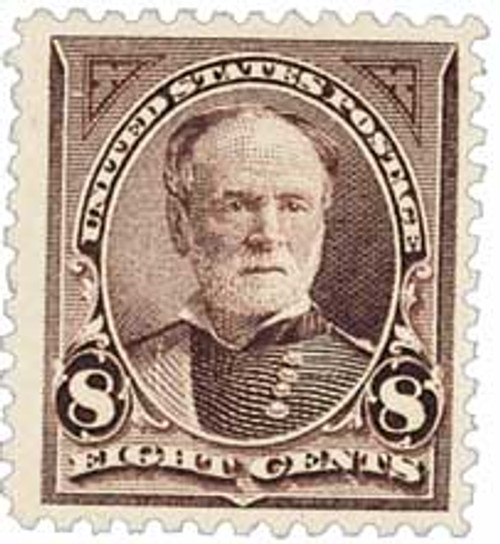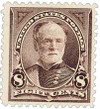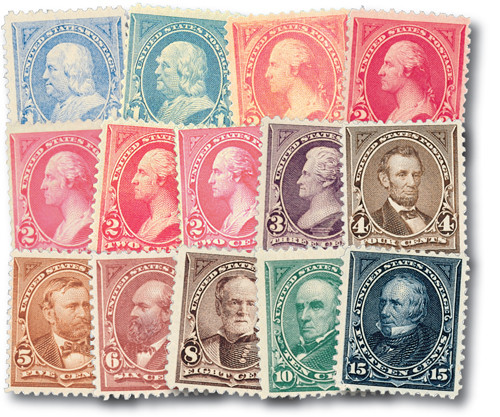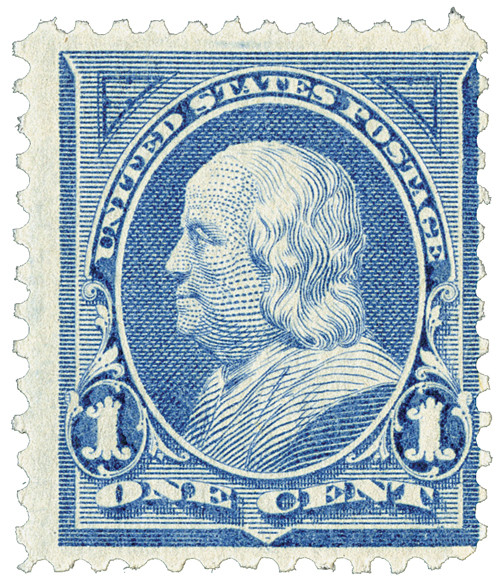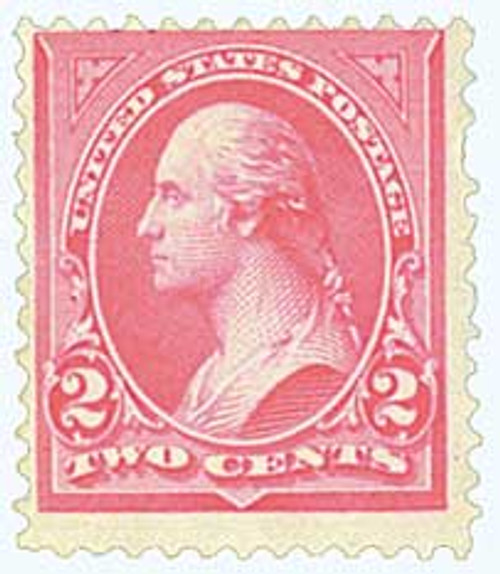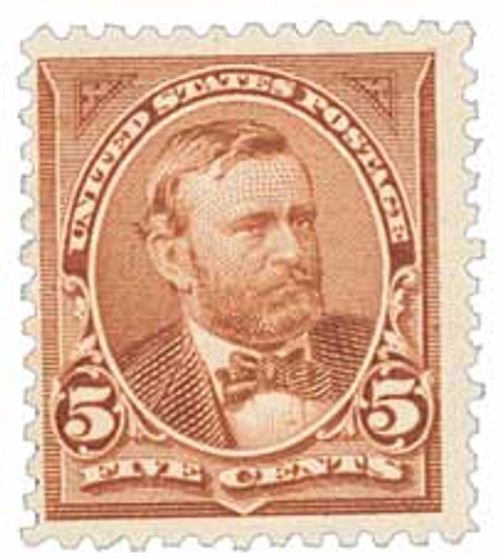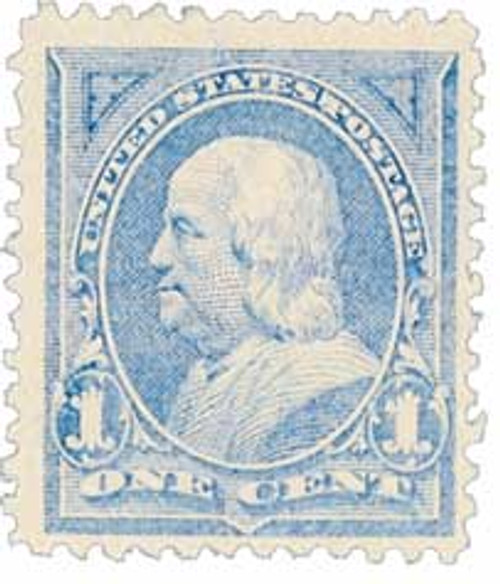
# 257 - 1895 8c Sherman, unwatermarked
1894 8¢ Sherman
Issue Quantity: 2,426,100
Printed by: Bureau of Engraving and Printing
Watermark: None
Perforation: 12
Color: Violet brown
Because there was still an adequate supply of 8¢ American Bank Note issues on hand, the 8¢ Sherman stamp was the last of the Series of 1894 stamps to be issued. In fact, it wasn’t released until 1895.
Sherman’s March To The Sea
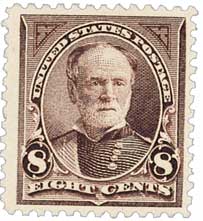
After burning Atlanta, Union General William Tecumseh Sherman embarked on his month-long March to the Sea on November 15, 1864.
Following his capture of Atlanta on September 2, 1864, Major General William T. Sherman turned his sights to Savannah, an important port city for the Confederacy. Traveling away from his supply lines, Sherman’s forces would forage area plantations for provisions. He wanted more from this campaign than to capture Southern land – he hoped to destroy the Confederacy’s ability to continue the war.
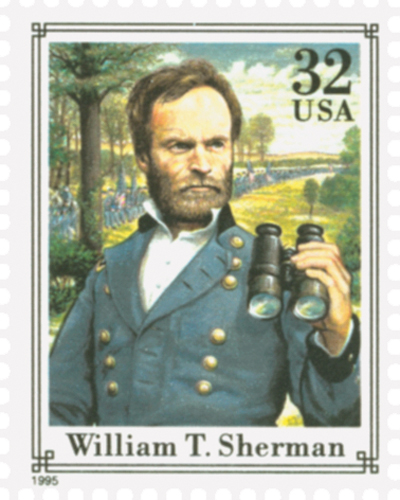
After setting fire to much of Atlanta, Sherman and his 62,000 men began their march toward Georgia’s eastern border on the morning of November 15. His first goal was to confuse the enemy about his army’s destination, whether toward Macon or Savannah. Sherman divided his force into two columns. Though they occasionally encountered small bands of Confederate forces, they prevailed each time.
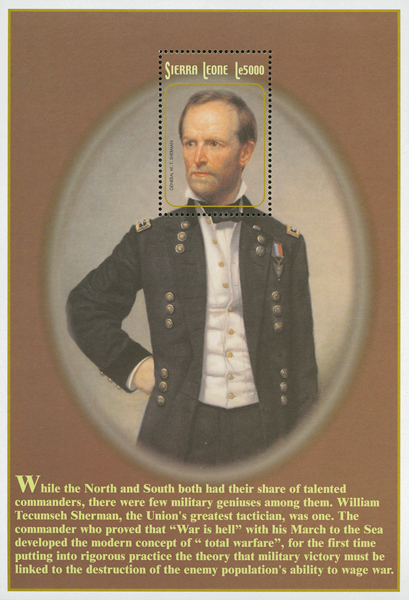
As Sherman’s army marched to the east, they targeted the industries and agriculture that resupplied Confederate forces. He set out to negatively affect the morale of the citizens who still felt the South could win the war. In addition to gathering corn, meat, and vegetables, Sherman instructed his officers to oversee the burning of mills and confiscation of horses and mules. If a village did not resist, the soldiers were told to leave the buildings standing. Those areas that burned bridges or organized guerrilla armies were, however, subject to “a devastation more or less relentless according to the measure of such hostility,” according to his field orders. With their objectives in mind, the Military Division of the Mississippi set out to permanently change the landscape of Georgia and the minds of its residents.
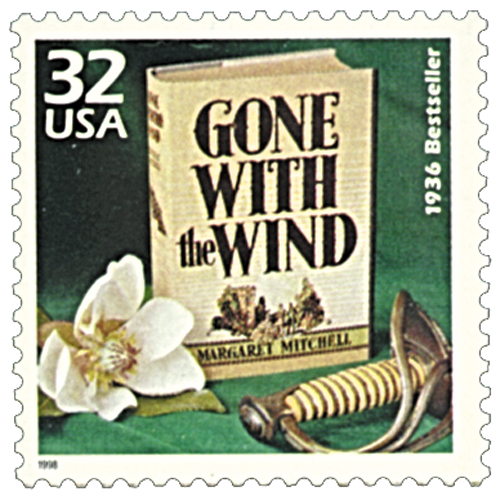
Sherman’s forces converged at the outskirts of Savannah on December 10. By this time, 10,000 Confederates were entrenched in the city. They had flooded the surrounding rice fields, leaving only narrow causeways to enter Savannah. This disrupted Sherman’s plan to meet up with the US Navy to be resupplied. He sent a division to capture the Confederate-held Fort McAllister and open an alternate route to the sea. On December 13, the division stormed the fort and overtook it in 15 minutes. Sherman was now able to get his supplies, as well as siege artillery to aim at Savannah.
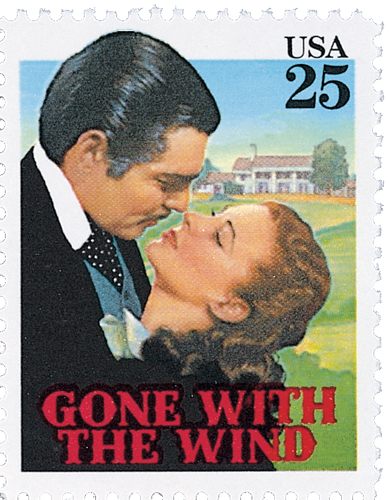
On December 17, Sherman sent a message to Confederate commander William Hardee “demanding the surrender of the city of Savannah” and promising “liberal terms to the inhabitants and garrison.” On December 20, rather than surrender, Hardee and his men escaped across the Savannah River on a makeshift pontoon bridge. The next morning, the city’s mayor rode out and told one of Sherman’s generals he would surrender Savannah in exchange for protection of the citizens and their property. The general telegraphed Sherman, who agreed to the terms. The division occupied the city that day.
Sherman sent a telegram to President Lincoln reporting, “I beg to present you as a Christmas gift the City of Savannah” along with guns, ammunition, and bales of cotton. Lincoln responded, thanking Sherman and his men, calling the campaign “a great success.”
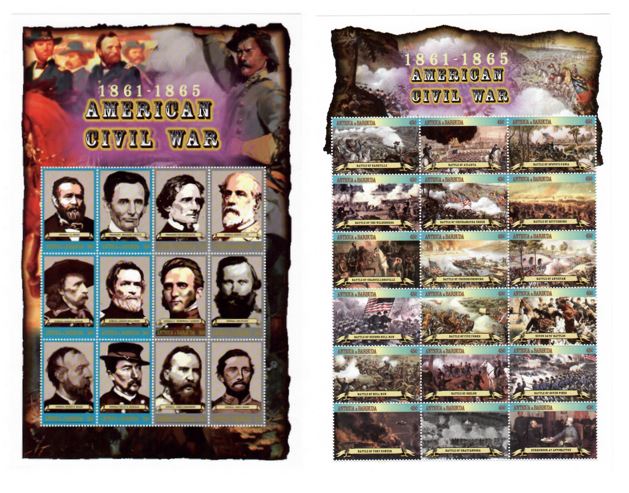
After spending the winter in Savannah, Sherman marched through the Carolinas. He continued his total war strategy in the successful two-month campaign. The army reached North Carolina by April 1865, and Sherman accepted the surrender of Confederate General Joseph Johnston on the 26th. Sherman’s strategy was effective in disrupting Southern supplies and lowering the morale of Confederates, but it came at a great cost. He estimated the campaign caused $100 million in damage. His reputation in the South was irreparably damaged as the citizens of Georgia held onto bitter memories of the destruction he was responsible for. In spite of this, historians say Sherman may have brought an early end to the war because of the loss of Confederate industries and crops.
1894 8¢ Sherman
Issue Quantity: 2,426,100
Printed by: Bureau of Engraving and Printing
Watermark: None
Perforation: 12
Color: Violet brown
Because there was still an adequate supply of 8¢ American Bank Note issues on hand, the 8¢ Sherman stamp was the last of the Series of 1894 stamps to be issued. In fact, it wasn’t released until 1895.
Sherman’s March To The Sea

After burning Atlanta, Union General William Tecumseh Sherman embarked on his month-long March to the Sea on November 15, 1864.
Following his capture of Atlanta on September 2, 1864, Major General William T. Sherman turned his sights to Savannah, an important port city for the Confederacy. Traveling away from his supply lines, Sherman’s forces would forage area plantations for provisions. He wanted more from this campaign than to capture Southern land – he hoped to destroy the Confederacy’s ability to continue the war.

After setting fire to much of Atlanta, Sherman and his 62,000 men began their march toward Georgia’s eastern border on the morning of November 15. His first goal was to confuse the enemy about his army’s destination, whether toward Macon or Savannah. Sherman divided his force into two columns. Though they occasionally encountered small bands of Confederate forces, they prevailed each time.

As Sherman’s army marched to the east, they targeted the industries and agriculture that resupplied Confederate forces. He set out to negatively affect the morale of the citizens who still felt the South could win the war. In addition to gathering corn, meat, and vegetables, Sherman instructed his officers to oversee the burning of mills and confiscation of horses and mules. If a village did not resist, the soldiers were told to leave the buildings standing. Those areas that burned bridges or organized guerrilla armies were, however, subject to “a devastation more or less relentless according to the measure of such hostility,” according to his field orders. With their objectives in mind, the Military Division of the Mississippi set out to permanently change the landscape of Georgia and the minds of its residents.

Sherman’s forces converged at the outskirts of Savannah on December 10. By this time, 10,000 Confederates were entrenched in the city. They had flooded the surrounding rice fields, leaving only narrow causeways to enter Savannah. This disrupted Sherman’s plan to meet up with the US Navy to be resupplied. He sent a division to capture the Confederate-held Fort McAllister and open an alternate route to the sea. On December 13, the division stormed the fort and overtook it in 15 minutes. Sherman was now able to get his supplies, as well as siege artillery to aim at Savannah.

On December 17, Sherman sent a message to Confederate commander William Hardee “demanding the surrender of the city of Savannah” and promising “liberal terms to the inhabitants and garrison.” On December 20, rather than surrender, Hardee and his men escaped across the Savannah River on a makeshift pontoon bridge. The next morning, the city’s mayor rode out and told one of Sherman’s generals he would surrender Savannah in exchange for protection of the citizens and their property. The general telegraphed Sherman, who agreed to the terms. The division occupied the city that day.
Sherman sent a telegram to President Lincoln reporting, “I beg to present you as a Christmas gift the City of Savannah” along with guns, ammunition, and bales of cotton. Lincoln responded, thanking Sherman and his men, calling the campaign “a great success.”

After spending the winter in Savannah, Sherman marched through the Carolinas. He continued his total war strategy in the successful two-month campaign. The army reached North Carolina by April 1865, and Sherman accepted the surrender of Confederate General Joseph Johnston on the 26th. Sherman’s strategy was effective in disrupting Southern supplies and lowering the morale of Confederates, but it came at a great cost. He estimated the campaign caused $100 million in damage. His reputation in the South was irreparably damaged as the citizens of Georgia held onto bitter memories of the destruction he was responsible for. In spite of this, historians say Sherman may have brought an early end to the war because of the loss of Confederate industries and crops.

